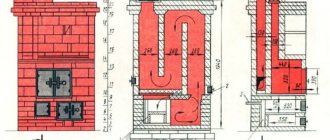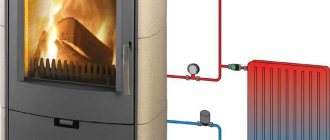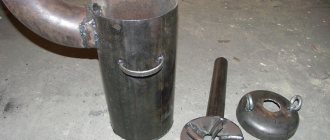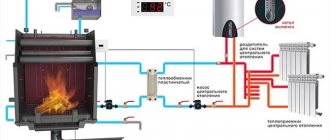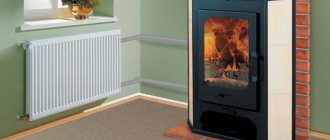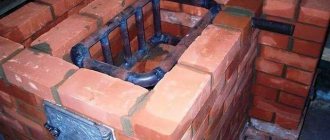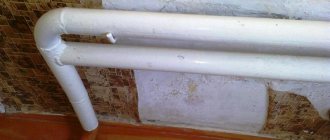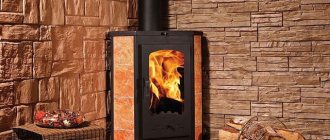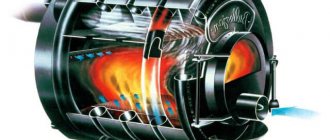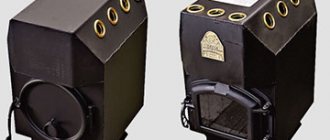How great it would be to have a beautiful fireplace in your house with a large glass door, and one so that the heat from the combustion of wood does not fly out into the chimney. So what's the problem? If after reading my article you have no doubts or new thoughts about installing a fireplace stove with a water circuit, then you can safely get down to business. And if they arise...
It is especially wonderful not to make excuses to yourself, your family and guests for your fireplace, its capriciousness, its specificity. Its small door or something else, which, in fact, often has to be sacrificed for the sake of the water circuit.
Of course, the matter is not only in the water circuit, but here we need to figure it out in order and “separate the flies from the cutlets”...
Product lines
The Angara series of fireplace stoves is presented on the Russian market in several versions: standard, with a heat exchanger and/or stove, as well as with increased dimensions.
1. Angara fireplace stove standard.
Specifications:
- A 9 kW oven heats rooms up to 90 sq.m.
- Dimensions – 1020×560×490 mm.
- Weight – 140 kg.
- Location – corner/front.
The basic model does not require a reinforced foundation. Small dimensions and wall placement allow homeowners to maintain enough free space in the room. Parts of the side surfaces of the furnace body are lined with ceramic tiles. The combustion chamber is lined with fireclay tiles on the inside. This protects the steel walls from burning out and increases the service life of the furnace. There are also cast iron grates inside, through which ash and ashes fall into the drawer. Below the firebox there is an open chamber for storing firewood. One stack of fireplace stoves consumes 3-4 kg of fuel. The burning time is about 4 hours. The strength of the flame is regulated using slide valves.
2. MetaFire Angara 12 series fireplace stove with stove.
Specifications:
- Heating area – 100-120 sq.m.
- Thermal power – 12 kW.
- Dimensions – 950×700×545 mm.
- Weight – 195 kg.
- Location – frontal.
The new stove features a larger combustion chamber volume and an improved heat exchanger. The extended functions of the model are manifested in the presence of a plate. The ability to simultaneously use a fireplace stove to heat the house and cook food brought Angara 12 into the ranks of top products.
3. Stove-fireplace with water circuit Angara Aqua.
Specifications:
- Heated area – up to 210-230 sq.m.
- The total thermal power is 18 kW.
- The water circuit capacity is 9 kW.
- The volume of the heat exchanger is 4 liters.
- Dimensions – 1020×550×490 mm.
- Weight – 150 kg.
A stove with a water circuit, Angara Aqua, heats the house using radiators. It is used in open/closed heating structures with forced/hydraulic coolant circulation. The original device and front placement provide accelerated heating. Softened water or antifreeze liquid can be used as a coolant. The fireplace is equipped with a door with heat-resistant glass “Neoceram NO” and a “clean glass” system.
For uninterrupted operation of the furnace, it is necessary to use coarse filters, safety structures and air vents. It is advisable to install thermostats on radiators. The Angara Aqua fireplace can be heated independently, without connecting to the water circuit. The system must be full. The heat exchanger operates stably under such conditions, but its service life is significantly reduced.
4. Meta Angara 12 Aqua fireplace stove with water heat exchanger.
Specifications:
- Heated area – 140-160 sq.m.
- Productivity – 16 kW.
- Dimensions – 1040×700×535 mm.
- Weight – 205 kg.
- Heat exchanger volume – 10 liters.
- Location – wall.
The water loop furnace is a new heating device with improved characteristics. The heat exchanger system ensures high combustion efficiency and reduced soot volume in the chimney. The large dimensions of the fireplace allow the use of large firewood. Decorative ceramic elements are used in the design of the stove lining. The combustion doors have a prismatic shape and are made of heat-resistant glass ceramics.
Review of popular models
There are many models of stoves and fireplaces on the market from different manufacturers, and it is easy for a buyer who is planning to buy them to get confused in the characteristics and descriptions of these devices. Below is an overview of the most popular models, according to reviews from Russian consumers.
AQUA stoves and fireplaces
The line of fireplace stoves with a water circuit from the META company is represented by the Angara, Pechora, Varta models, which differ in thermal power, shape and appearance, as well as installation method.
The AQUA hangar with a water circuit has the following characteristics:
- heating power emitted by the stove during combustion is 13-16 kW;
- heating power of the connected heating system - 5-7 kW;
- steel heat exchanger;
- wall-mounted version;
- the side walls are lined with ceramics;
- panoramic heat-resistant glass;
- outlet diameter of the smoke pipe is 150 mm.
Pechora AQUA differs from Ankara in the shape of the body - it is made in the form of a compressed prism . The power of the furnace is 13 kW, the heating system is up to 5 kW.
Varta AQUA additionally equipped with a hob that can be closed with a lid. Power 13/5 kW, firebox lined with fireclay. The door is straight, equipped with glass and heat-insulated handles that are resistant to heat. A special feature of AQUA fireplace stoves with a water circuit from the META company is the ability to connect only to systems with forced circulation.
Fireplace stoves Bavaria
Bavaria stoves, which have gained recognition among Russian consumers, are available in both wall-mounted and corner versions, and can also be equipped with a stove for cooking and heating food.
Eco-fireplace Bavaria in a wall-mounted version with a thermal power of 12 kW is equipped with a 6 kW heat exchanger, which can be connected to a system with any type of circulation. The connection diagram is shown in the figure.
The corner model of the Bavaria fireplace differs only in shape and thermal power (11 kW/5 kW), other characteristics are similar.
Advantages of Bavaria stoves:
- firebox made of heat-resistant steel 6 mm, lined with fireclay;
- cast iron heat-resistant grates;
- heat-resistant panoramic door glass with a self-cleaning system;
- long burning mode available;
- the smoke pipe is located at the rear, which allows the use of Bavaria stoves with chimneys of any type;
- the side surfaces of all Bavaria models are lined with tiles in different colors;
- the stoves are equipped with a hob, which makes them universal;
- simple design and detailed instructions allow you to buy and install these models yourself.
Consumer reviews from Bavaria fireplaces speak of their convenience and efficiency both when used for constant combustion and for periodic heating of country houses.
Review of popular fireplace stoves with a water circuit
Types of fireplace stoves according to design characteristics
Modern manufacturers produce water fireplaces for heating small houses and large rooms. Consumers prefer several options:
- Koza/K6, Kratki. Compact heating unit for a small house with adjustable flame intensity. The power is 8 kW, the firebox is made of cast iron.
- Bavaria Three glasses, EcoFireplace. A stove with an original design of a steel firebox glazed on three sides. The chimney is connected from above and from behind. A heater with secondary combustion mode can heat a room for about 6 hours.
- Professor Butakov, Termofor. Available with a door made of steel, cast iron with a window and a shielded convection pipe system. Suitable for equipping a warehouse, hangar for 1000 square meters. The efficiency is 80% due to the direction of air into the afterburning chamber by special jets.
- Happy Red, MBS. Stylish fireplace for a room of 45 m2. Made from steel and cast iron using a frame method. The firebox is framed with fireclay, and the temperature difference is smoothed out by a vermiculite chipper. Efficiency – 82%.
- PC-01, Vesuvius. A model with a hob will heat a house of 150 square meters. The firebox is heated by an electric fan, heat release during long-term combustion is 5 hours. The combustion intensity is regulated by the blower flap.
- Lava, Guca. The cast iron device with a heating area of 89 m2 is equipped with two regulators - in the firebox and in the ash pan. The chimney is connected at the rear or side.
All fireplace stoves are safe and equipped with operating instructions.
Which fireplace inserts are better, how to choose
When choosing a fireplace insert, we first take into account the operating conditions and the possibility of access. It’s one thing if the fireplace is for beauty and joy. It’s completely different if it’s for heating. By the way, for heating the fireplace can operate in different modes. Somewhere constantly and as the main source, somewhere only on the coldest days, as an additional source and for comfort. The best fireplace insert will be completely different in each case.
Perfect picture!
The best fireplace insert: what we should definitely look at
The difference in price for fireplace inserts is very, very impressive. The cheapest ones (non-Chinese, those are even cheaper) can be found for 100-300 €. The average price range is 500-1500 €. The price for expensive ones starts from 3000-4000 €. It is clear that this is not just like that and there is a difference. The best fireplace insert is different for each range. However, there is a certain set of characteristics that are necessary in any case:
- High-quality metal, sufficient wall thickness. It is clear that the metal of expensive and cheap ones cannot be the same, but the quality of the metal itself, the thickness of the walls and the quality of the connection of parts is worth monitoring. The thickness of the metal on the roof of the firebox is very important - this is where the temperature load is greatest.
- Convenient ash pan. In expensive models there is often no ash pan at all, but that's another story. On this point, the best fireplace insert is one in which the ash pan can be pulled out, cleaned, and then put back in without any problems. Believe me, it’s not easy to find one among inexpensive ones. Points that allow you to decide what is the best fireplace insert for you
- Hermetically sealed door. There are several positions here and the best is a fireplace insert in which all the conditions are met: Sealing the gap between the glass and the frame. The best option is a heat-resistant cord. Cheaper - sealant. Both should be around the perimeter.
- Pressing the glass to the frame. Not with several holders, but with a corner that is fixed with screws.
- The perimeter of the door must be lined with heat-resistant cord. Not on two or three sides, but along the perimeter. And the cord should be voluminous and protrude beyond the groove. Then, when the door is closed, air will not be sucked in.
To choose, you need to look and feel for yourself.
Why is tightness important? Because a fireplace insert with a door is needed so that you can select the combustion mode. If air enters only through adjustable dampers, you can extinguish the flame and switch the unit to long-burning mode - when the wood smolders rather than burns. This helps save fuel and regulate the temperature in the room. And the best fireplace insert, definitely, which really allows you to regulate the air supply.
Additional options, but not superfluous
There are a few other factors that will be helpful. Double or mirror glass and its self-cleaning system. Double (cheaper option) or mirror glass allows you to reflect most of the heat rays into the firebox. The benefit is double. First, the temperature in the firebox increases, which promotes more efficient combustion of fuel. Second, it’s not so hot in front of the door.
Self-cleaning system - air supply to the glass, which carries soot deep into the firebox. Due to this, the glass does not smoke so quickly (although it does smoke anyway), the soot is burned, which is also a plus. This, by the way, is a secondary air supply to the firebox. Air is supplied directly to the burning wood, and not from below, which also improves the degree of combustion. But these dampers must also fit well.
The lining is needed to protect the steel or to gain weight - to obtain an inertial fireplace
The presence of a gate (damper) at the outlet of the chimney. The gate also allows you to control the intensity of combustion. This is convenient - reduce the draft, close the dampers and the wood barely burns. But the absence of a damper in the fireplace insert is not critical - it can be placed on the chimney. You will have to move the knob outward to adjust, but everything is possible and not too expensive.
Comfortable and/or cool handle. Opening/closing the door of a burning fireplace and not being afraid of getting burned is important. Since metal can heat up to very high temperatures, it is necessary to make not only nozzles, but also inserts from materials that do not conduct heat well. You can put up with a hot handle if it is comfortable and easy to open/close even with a mitten. So the best fireplace insert is one with a comfortable and reliable handle.
Interesting design option
Possibility of taking combustion air from the street. With properly functioning ventilation, there is enough oxygen in the room even after burning for many hours. The situation is worse with humidity. In the presence of open fire, it becomes very low. This is bad for your well-being, but not only that. Humidity is important for wooden houses. They have a minimum acceptable level of 50%. Otherwise, the wood dries out, cracks, and twists. When the fireplace is operating for a long time, the humidity can drop to 20-35%, and this is a problem. This can be solved by installing humidifiers, but it is easier to maintain humidity if air from the street is supplied to the fireplace.
Deciding on the price category: cheap and expensive, what’s the difference?
As already mentioned, the difference in price for fireplace inserts is colossal. It is clear that higher quality cast iron is used (black instead of gray, for example). It is clear that the casting itself is of higher quality, the parts fit better, the glass is more expensive, etc. There really are differences. Let’s skip the technical and technological details and features, and consider how expensive and cheap fireplace inserts differ during operation.
- Duration of wood burning . In cheap ones, you need to add firewood once every 2-3 hours (more like once every 2 hours). That is, the consumption of firewood is high and someone needs to constantly monitor whether there is fuel or not. In expensive ones - in normal mode - firewood is added once every 4 hours, in smoldering mode once every 6-8 hours.
- Flame adjustment options. In cheap ones it is very rarely possible to achieve a reaction to closing/opening the dampers. You'll be very lucky if there's any difference. In expensive ones, the firebox can easily be switched to smoldering mode, limiting the access of air.
The main thing is to evaluate the differences in operation - Glass cleaning system . Everyone claims this option is available. And indeed, if not everyone, then most have a gap in the door. Some even have shutters. Glass still smokes in both expensive and cheap ones. But in expensive ones it must be cleaned after 10 fireboxes or more, and in cheap ones at least twice as often. But that's not all. In expensive ones, plaque appears in smoldering mode, when the temperature in the firebox is low, which contributes to the appearance of soot. Once you heat it a little at full power, it will clean itself. In cheap ones, plaque occurs constantly - due to the low temperature and large amount of fuel burned per unit of time.
- The need to remove ash and coals . In most fireplace inserts, air is supplied to the chamber through the ash pan and grate. That is, from below. During combustion, larger coals remain on the grate, smaller coals and ash fall into the ash pan. All this interferes with the air supply. This means that you must often clean the ash pan and grate from coals and ash. In the cheapest ones - after 2-3 fires, in more used ones - after 5-10 fires, in expensive ones - once every one and a half to two weeks. Some expensive ones do not have an ash pan; air is supplied from above. As a result, the wood burns completely, leaving a small pile of ash.
One of the Polish manufacturers from the middle price segment is TRNAVA.
It is not yet presented in Russia, but it looks great. This is what distinguishes expensive fireplace inserts from cheap ones during operation. Nobody says that cheap ones are not worth buying. They also provide warmth, create comfort, a special atmosphere, and also allow you to admire the flames. There are very good ones for little money. But they have shortcomings, and usually all at once. They are simply expressed to a greater or lesser extent. It is important that you understand what to expect and decide what the best fireplace insert means for you.
Advantages and disadvantages of fireplace stoves
Not a single heating unit is without drawbacks, which should be described first. So:
Operating mode – manual. You will have to constantly add firewood and optimize traction. The efficiency, unlike a gas or electric boiler, is low - 75-80%.
However, these disadvantages more than outweigh the advantages. This:
- Low cost of the unit.
- Possibility of combination with other media - diesel, antifreeze.
- Fuel for a wood fireplace is cheaper than electricity.
- Fast heating of the room.
- Any fireplace stove with water heating is independent of energy resources.
- A wonderful interior attribute.
And that is not all. The models combine not only heating functions, but also cooking functions - this is an excellent purchase for a summer house, where there is no other source of heat and resources for cooking. Disadvantages that are significant for purchasers can be easily eliminated if the system is modernized.
Features of connection to the heating system
A water fireplace is connected to the system if there is a coolant in the circuit, taking into account its circulation.
Natural type of circulation
Location of pipes with forced and natural circulation
Units with a water circuit are connected as follows:
- Construction of an accelerating manifold behind the heat exchanger to raise the coolant to the highest point.
- Installing the expansion tank at the top.
- Construction of a heating main from pipes of at least 32 mm in diameter.
- Maintain a slope of 5 cm per 1 m for normal circulation.
Forced circulation type
Forced water circulation provides several nuances:
- the expansion tank is placed on any section of the highway;
- batteries can be connected in any way;
- It is not necessary to observe the slope of the route;
- To prevent condensation from appearing in the firebox, you can use an automatic unit.
Heating distribution systems
When organizing a heating distribution system, it is worth considering that they come in two varieties: open and closed.
In the first case, water circulation occurs due to the inclination of the pipeline. Heated water is supplied to the highest point. After this, it passes through the entire pipeline by gravity. The level gradually decreases. Water returns to the boiler through a pipe called return. An expansion tank is installed in the attic to allow for expansion as temperatures increase. The heated water is forced into the expansion tank; with gradual cooling, the reverse process is observed.
The main advantage of an open system is its simplicity. Installation can be done independently. However, it is not suitable for heating a large area.
Chimney
The pipe that will be connected to the firebox can be made of the following materials:
- rough steel with a thickness of at least 2 mm;
- enamelled steel with a minimum thickness of 1 mm;
- high-alloy chromium-nickel steel 0.6 mm thick;
- titanium-containing steel 0.6 mm thick.
Standards for installing a chimney to a fireplace stove
In places where the chimney passes through the ceilings, additional thermal insulation must be installed.
To do this, use basalt cardboard, after which you need to install a special adapter.
Passage units in the ceiling must be sealed with basalt, and then closed with a special lid.
Treat all joints of the structural elements of the chimney with heat-resistant sealant.
When connecting an elbow at a right angle, provide an inspection hole for cleaning the system.
Fuel requirements
Hornbeam, oak, birch or aspen logs are ideal for lighting the stove. When burning, they emit less soot and smoke.
You should not buy coniferous wood, cherry, willow and elm. They are characterized by a large amount of resin and soot. Logs can produce sparks, which increases the risk of fire and negative impact on human health.
Firewood should be lit with birch bark, wood chips, paper products or a special liquid. It is imperative to ensure that during the process the gate valve is open all the way and that there is sufficient aeration in the ash pit.
By the way, the usual wood-burning stoves-fireplaces are far from the only type. For some time now, they have been in no way inferior in popularity to gas, electric analogues and those that run on special biofuel.
Specifications
European manufacturers of fireboxes with a water circuit manufacture them according to the German DIN+ standard. In Russia, it is necessary to take into account not only these standards, which determine the technical characteristics of stoves, but also heating standards. It is better to understand the features of fireplace production and their capabilities using the example of Spartherm Varia 1V H2OXL. The dimensions of the stove are exactly the same as they would be if it did not have a heat exchanger: width - 75 cm, height - 123 cm, depth - 55 cm.
To calculate the compliance of the technical characteristics of the stove with heating needs, a house with a total area of 160 square meters was selected as an example. meters. According to Russian heating standards, at a temperature outside the window of -27 degrees Celsius, spend 1 square meter on heating. meters you need no more than 50 W every hour. The rated power of this firebox is 14 kW, of which 10 kW is provided by the heat exchanger, 4 kW by thermal radiation. There are two glasses in the firebox door: the inner one has a film that reflects heat, so as not to overheat the building and not burn the skin when touched; the outer one is decorative.
The calculation period is 5 days, during which the stove will heat the house all day. In 12 hours, the fireplace produces 14 kW hourly, of which 8 kW is spent on the heating needs of the house (radiators, etc.). 1 kW is spent on heating water for domestic use. The boiler accumulates the remaining 5 kW every hour. On average, throughout the day it can accumulate about 60 kW, which will be used to heat the house at night. To accumulate such an amount of heat, the storage boiler must have a volume of at least 700 liters.
How it works - video guide
What do we usually expect from a fireplace?
When we - you, me or anyone else - sitting in front of a computer screen, drawing our project or just thinking about the topic of heating a house, think about a fireplace and heating a house (especially if we think about the first and second at the same time), we often forget the primary expectations from the fireplace itself. Firstly, we forget the difference between an open fireplace and a fireplace with a door. And it is significant if the door is ordinary. The fact is that fireboxes come in “grate” and “hearth” types. I recently wrote a separate article about this, “Modern fireplace door with fireproof glass - important features!”
Many people know very well what the beauty of open fireplaces is. But it's unlikely that many people can distinguish between the important features of a fireplace insert (or any fireplace with a door) and an open fireplace. And even more so, fewer people will be able to choose a door behind the glass of which the fireplace will burn with the effect of an open fireplace - a good hearth door. The vast majority of steel fireplaces and any fireplaces with doors are grate. This is required for heating efficiency. The combustion in them is completely different; the aesthetics of burning wood in them will never compare with an open fireplace or a fireplace with a good hearth door.
Secondly, here is my personal experience and the experience of my colleagues. In order not to constantly put off starting the fireplace and generally be able to enjoy the view of the flame, the fireplace should be located in the most visible place in the living room. Also, he should not occupy a key place - so as not to get in the way. This is, of course, obvious, but when the question of the water circuit arises, we begin to scroll through the many placement options for profitable home heating. Often, we forget about the above-mentioned obviousness for the sake of heating efficiency.
Pros and cons of water stoves-fireplaces
With natural circulation of the coolant, you can get by with wood alone - without electricity or gas
Fireplace inserts and stoves with a liquid heat exchanger have a number of advantages:
- independence from electricity and gas - firewood is used for stowage;
- compact dimensions, suitable for any area of the room;
- Can be used for heating and cooking;
- maintaining a comfortable temperature in a large house;
- uniform distribution and supply of heat to distant rooms;
- high efficiency with minimal fuel costs;
- operation of stoves with a circuit and a tank for hot water supply;
- safety - the outer parts of the housing with lining do not heat up;
- connection to a radiator heating system.
A stove fireplace with a water system has several disadvantages:
- minimal automation of brick and metal models;
- time spent on laying the firebox and igniting the fire;
- formation of soot, soot and smoke when using firewood from coniferous trees, cherry, willow;
- rapid cooling of steel modifications;
- Not all units are suitable for burning coal.
Unique options for fireplace inserts made of cast iron with descriptions
You can create the desired atmosphere of comfort in your home yourself, or it is better to turn to professional designers who can always suggest the right choice. But sometimes the opinions of experts can be divided, for example, reviews about fireplace inserts are always different. Some people believe that steel is more reliable, but this is not always true. An excellent and popular option are cast iron fireplace inserts, which can be made differently or decorated on the outside, which makes them much more attractive. Here are a few modern solutions that can be successfully used to create a high-quality and respectable heating system:
- Special technology with a lifting door that allows you to instantly close the heating device. This will cause the fire to completely extinguish, which is very convenient in a situation when you are in a hurry to leave the house;
- A corner option that looks great from both sides due to the ability to create a double view - from the front and the side. This option is performed using special side glass;
- The three-sided option is made using a similar technology as in the previous case, only now it is possible to see the fireplace from three sides at once;
- It won’t be difficult to order and make a semicircular firebox, which can look great as a corner option or in a living room[/anchor];
- It is possible to design and execute a widescreen look that is somewhat reminiscent of a large TV.
cast iron fireplace insert in the interior
cast iron fireplace insert
Many buyers and customers speak differently about fireplace inserts, as there are distinctive features of different materials. But it should be noted that the cast iron option is considered more practical, since it is cheaper in cost and easier to install. Specialists also prefer this type more because it can create a variety of shapes and it is faster and less expensive than in the case of steel. Although opinions are divided, the majority still choose cast iron fireplace inserts, which is confirmed by many comments on the Internet and the point of view of consultants in specialized stores.
Today in the current construction market there are many different solutions for arranging your home. You should definitely pay attention to the materials from which ready-made structures are made. Quality engineering with durable components can provide a long-lasting heating device for your home. You first need to analyze the possible options, and then make a final decision. In the next article we will talk about fireplace stoves, consider reviews from experts and the price range.
Delivery to regions
We can deliver your order to any region and city in Russia. The cost of delivery depends on the distance between cities, weight, volume of the goods and is calculated when ordering the goods. On the page of each product in the delivery section, you can specify the city and find out the cost and delivery time of the product. You can write to the delivery service at the address, indicating the product you are interested in, the exact delivery address (pickup warehouse or your address) and the delivery service will calculate the cost of shipping the goods. You can also get advice by phone: 8 (495) 926-26-22. Payment for goods in case of delivery to the region is made by bank transfer with 100% prepayment or by card through the website, or can be paid by your representative in Moscow in cash. All necessary documents are transferred along with the goods or to your representative.
The delivery time depends on the distance and the product and ranges from 2 days to the nearest regions and up to 2 weeks to the most remote corners of the country.
You can calculate the cost of delivery to your region on the product page in the delivery section. We will deliver the goods to the shopping center for free when ordering a chimney kit or order amount over 100,000 (except for promotional items). The cost of delivery to shopping center for orders from 60,000 to 100,000 and promotional goods from 100,000 is 1990 rubles. For orders up to 60,000 - 2990 rub.
Close
Operating rules for furnaces
When using a fireplace with water heating for your home, you should not:
- use other types of fuel not intended for the selected model;
- use flammable flammable liquids for kindling purposes;
- add firewood that is much larger in size than the dimensions of the chamber;
- ignore the appearance of cracks on glass surfaces;
- use the elements of the device to dry clothes or other materials;
- place objects that could ignite from close contact closer than 1.5 meters from the heated surface;
- overfill fuel storage areas with logs and things that can catch fire;
- overload the chamber by adding excessive amounts of firewood;
- extinguish the flames inside with water;
- attempt to remodel the fireplace stove yourself or use it for other purposes;
- remove not yet extinguished coals and ash;
- leave a working device unattended;
- block smoke ducts while wood is burning.
Under no circumstances should children be allowed to operate the device.
Requirements for installing a fireplace stove
We must not forget that a fireplace stove for heating a house is an engineered system that has a fire hazard and negligence in this matter is inappropriate.
So, what are the requirements for the place where the fireplace is installed?
- For wooden or houses made of other combustible materials, it is recommended to purchase a unit with a closed combustion chamber. This will prevent accidental sparking and, accordingly, reduce the risk of fire.
- For brick objects, this rule is also relevant, but the risk of fire is less. To combine business with pleasure, choose a fireplace stove with a fireproof glass door. So, the style will not be compromised and safety will be maintained.
- The chimney must be individual. That is, the place where the fireplace will be installed must be equipped with a channel for exhaust gases in advance.
- The base for the fireplace stove must be carefully prepared. You should not look at the fact that each model is equipped with a compartment for storing firewood - they are laid out 1-2 times.
- Walls located next to fireplaces must be protected from heating and burning with special materials - sheet iron, asbestos sheets and other raw materials that do not react to heat.
- The distance to each wall should not be less than 0.8 cm. Otherwise, condensation will form on the outer surface, which is bad for both stone and wood.
It can be hidden in the wall, then the aesthetics will be preserved. The remaining outlet from a solid fuel stove is also suitable, but it must be single-circuit and the old stove must be dismantled.
It is forbidden to place stoves or fireplaces for heating a house directly on a wooden floor. Either a special brick podium is made, or the floor is dismantled and the base is poured with concrete.
Owners who care about the complete safety of their home can adhere to the rules of SNiP 31-02-2001 and SNiP 41-01-2003, which specify the details of ventilation and chimney installation.
Payment for the order
1. Payment in cash to the courier upon delivery of the goods (only for residents of Moscow and the Moscow region) or at the pick-up point.
2. Payment by bank transfer to the organization's current account according to a pre-issued invoice. The price for some products may be changed for this type of payment.
3. Payment by credit card upon delivery of goods (only for residents of Moscow and the Moscow region). It is necessary to warn the manager about this payment method when placing an order.
4. Payment by credit card from the site. When placing an order, notify the manager that you want to pay from the site. The price for some products may be changed for this type of payment.
5. Payment by electronic money.
6. Payment through terminals.
If you have chosen to pay in cash to the courier or by credit card upon delivery of the goods, then you can pay for the purchase directly with the courier of our store at the time of delivery of the order. Payment is accepted only in Russian rubles upon delivery of goods and transfer of all necessary documents. This payment method is only available to individuals.
For individuals living outside the Moscow region and receiving goods through a transport company, as well as for legal entities, payment is made in cashless form to the store’s bank account. In this case, payment for the order is made according to the issued invoice, which you can receive at the fax number or email address you specified.
The best long-burning fireplace stoves with a water circuit
MBS Thermo Vesta plus
Intended for heat supply to premises equipped with water heating systems. The stove can be connected to the system in tandem with a solid fuel boiler or in independent mode.
The maximum possible water temperature inside the heat exchanger is 90°C.
The stove is made of high quality cast iron and steel. The outer enamel coating is particularly aesthetic and retains its attractive appearance for a long time.
There is a continuous cooking surface made of cast iron.
Rapid heating of the room is ensured by convection. The ash drawer can be pulled out directly during lighting, which simplifies maintenance.
Characteristics:
- power: 11 kW;
- Efficiency - 83%;
- hob - yes;
- location: wall;
- heating area - up to 110m2;
- chimney: 150mm, ;
- material: steel, cast iron, ceramic tiles, fireclay;
- glass type: straight;
- dimensions: 90*46*44cm;
- weight: 91.5 kg.
Advantages:
- design;
- build quality;
- high efficiency and long-term heat retention.
Flaws:
The internal surface of the firebox may require replacement after just a couple of years of use.
MBS VULKAN
A wood-burning stove-fireplace can heat large rooms while having compact dimensions. Perfect for use in a country house outside the city.
It will help organize autonomous heating or supplement the existing one.
The firebox is voluminous, and fuel is consumed in economy mode.
With the MBS Vulcan Thermo stove, your home will not only have a unique atmosphere, but also be more comfortable. There are modes of intense heating or smoldering.
Characteristics:
- power: 24 kW;
- Efficiency - 83%;
- hob - yes;
- location: wall;
- heating area - up to 140m2;
- chimney: 120mm, ;
- material: steel, cast iron;
- glass type: straight;
- dimensions: 65*78*64.5cm;
- weight: 151kg.
Advantages:
- ease of kindling and maintenance;
- high reliability;
- room heating rate;
- fuel economy.
Flaws:
none.
Romotop GRANADA
The stove has a modern appearance, high quality workmanship and uses an innovative method of burning wood.
The body is made of steel covered with decorative tiles. Steel stoves heat the air faster - already 15 minutes after lighting.
The combustion chamber is equipped with chamotte that can withstand up to 1300 degrees. The combustion chamber is separated from the body to reduce the risk of fire and extend the life of the stove itself.
Characteristics:
- power: 13 kW;
- location: wall;
- heating area - up to 130m2;
- chimney: 150mm, ;
- material: steel, ceramics;
- glass type: straight;
- dimensions: 125*50*56cm;
- weight: 254kg.
Advantages:
- modern design;
- wide choice of body colors;
- heating efficiency.
Flaws:
high price.
META Pechora Aqua
Pechora is one of the most efficient fireplace stoves that can effectively heat a large house. The installation is connected to heating radiators.
The stove warms up in a matter of minutes, and the fireplace itself is made of non-combustible materials, the main one being stainless steel. If you need to heat a small room, this model is suitable for that.
Then it does not need to be connected to the water heating circuit; the air heating power will be sufficient. You cannot connect the stove to heating radiators if there is no water in the radiators.
Characteristics:
- power: 9 kW;
- location: wall;
- heating area - up to 90m2;
- chimney: 150mm, ;
- material: steel, ceramics;
- glass type: straight;
- dimensions: 104*75*49cm;
- weight:155kg.
Advantages:
- does not take up much space;
- economical consumption of firewood;
- smoldering mode.
Flaws:
cools down quickly.
EdilKamin Warm CS
The stove belongs to a new generation. Depending on the area of the room, you can choose the Warm Base or Warm Scaldavivande configuration.
This stove can not only heat your home, but also provide hot water.
The design is in a classic rustic style, but will also fit into a modern interior. The ends, facade and base are cast iron, the hearth is made of steel, the cladding is made of ceramics.
Characteristics:
- power: 14 kW;
- location: wall;
- heating area - up to 140m2;
- chimney: 150mm, ;
- material: cast iron, steel, ceramics;
- glass type: straight;
- dimensions: 108*56*51.5cm;
- weight: 253kg.
Advantages:
- efficiency;
- heating and hot water;
- reliable components;
- perfect assembly.
Flaws:
high price.
Water circuit connection
You can connect the fireplace to the existing heating system in the house. Pipes for water supply and drainage, as well as a chimney pipe, are connected to the fireplace. If it is necessary to heat the floor for a private house, additional pipes for water circulation are installed in the boiler.
When connecting the water circuit, the following important points must be observed:
When connecting the water circuit, the following important points must be observed:
- installation on a flat surface. If it is not possible to level the floor on which the fireplace will stand, you can use adjustable legs. Uneven installation entails operating hazards and a significant reduction in the efficiency of the fireplace;
- mandatory check for leaks after filling the system with water. First, you should check all pipe joints without applying pressure. Then, turning on the circulation pump, once again eliminate leaks and leaks in pipes and joints. It is also necessary to ensure the tightness of the chimney by covering the joints with heat-resistant sealant;
- checking the operation of the fireplace and water heating. Do not be alarmed by the smell from the fireplace when you first light it - it will disappear within a short time. It is necessary to check the correct operation of the automation: how accurate is the regulation of the water temperature in the radiators, is it possible to regulate the speed of its supply.
Payment for the order
1. Payment in cash to the courier upon delivery of the goods (only for residents of Moscow and the Moscow region) or at the pick-up point.
2. Payment by bank transfer to the organization's current account according to a pre-issued invoice. The price for some products may be changed for this type of payment.
3. Payment by credit card upon delivery of goods (only for residents of Moscow and the Moscow region). It is necessary to warn the manager about this payment method when placing an order.
4. Payment by credit card from the site. When placing an order, notify the manager that you want to pay from the site. The price for some products may be changed for this type of payment.
5. Payment by electronic money.
6. Payment through terminals.
If you have chosen to pay in cash to the courier or by credit card upon delivery of the goods, then you can pay for the purchase directly with the courier of our store at the time of delivery of the order. Payment is accepted only in Russian rubles upon delivery of goods and transfer of all necessary documents. This payment method is only available to individuals.
For individuals living outside the Moscow region and receiving goods through a transport company, as well as for legal entities, payment is made in cashless form to the store’s bank account. In this case, payment for the order is made according to the issued invoice, which you can receive at the fax number or email address you specified.
Design features
A fireplace stove for a home with water heating has a steel chamber in which fuel is burned, the incoming cold masses are heated and heat is transferred to the coolant. In most cases, the design consists of the following elements:
- Steel body. Steel thickness up to 6 mm.
- Safety and air valves.
- Circulation pump.
- Filter.
- Radiator.
- Instrumentation – thermometer and pressure gauge.
- Expansion tank.
The furnace device is controlled manually. For these purposes, various valves are provided to regulate draft and, accordingly, boiler power.
Types of water furnaces
- installations running on traditional wood. Let us make a reservation that such fireplaces should not be too productive, since failure of the fireplace is inevitable earlier than necessary.
- The Buleryan stove is different in that it does not require the installation of a special register for heating the coolant. In Buleryan, water or antifreeze is heated in the furnace itself, and to increase the productivity of the device, an additional compartment is provided where wood gas is supplied.
- Heat stoves made of durable cast iron are devices based on a cast iron body where heat is produced. Very good stoves, in simple terms, they are bought “for centuries”, since cast iron is one of those materials that have high durability and reliability of their use. Only the water body in the device is made of thermal steel, everything else is cast iron.
- the simplest: by reducing or increasing the portion of fuel, they affect the decrease or lowering of the temperature mark.
- To transform temperature conditions, a special damper-regulator is used.
- The use of a circulation pump affects the rhythmic heating of the house.
Sources
- https://domspechkoy.ru/pech-kamin-s-vodyanym-konturom/
- https://gidpopechkam.ru/kaminy/pech-kamin-s-vodyanim-konturom.html
- https://expert-dacha.pro/otoplenie/pechi/pechi-kaminy/s-vodyanym-konturom-otopleniya.html
- https://zapodlico.ru/kak_organizovat_kamin_s_vodyanym_konturom_otopleniya_plyusy_i_minusy
- https://feflues.ru/blog/kaminy/pech-kamin-s-vodyanym-konturom-dlya-otopleniya-doma/
- https://www.tproekt.com/kamin-s-vodanym-konturom/
Advantages of fireplace stoves
Fireplace stoves combine the positive qualities of these heating devices, while they are devoid of their inherent disadvantages. What are the main differences between a traditional stove and a fireplace?
- The oven takes a long time to heat up, but is able to accumulate heat and radiate radiant energy from the walls of the oven into the surrounding space for a long time. The heat from the fireplace immediately spreads throughout the room in which it is installed, but after the fire stops, it quickly cools down and the temperature in the house decreases.
- The heating furnace is usually fired with a small blind door, this reduces the likelihood of smoke and helps improve draft. The firebox is open and occupies about half the area of its façade. If the chimney is not installed correctly or bad weather conditions, reverse draft and smoke may enter the room, which leads to an unpleasant odor, deposition of soot and soot on household items.
- The smoke exhaust system of the furnace has a complex design: the smoke in them passes through numerous channels, giving off most of the heat to the body of the furnace. It comes out of the pipe almost cooled down. The chimney in the fireplace is almost straight, the smoke is retained only under the arch, so its outlet temperature is much higher, and the heat removal is worse.
- The efficiency of heating stoves is on average 60-80%, for fireplaces - no more than 50%.
- The stove is not very decorative, and it can only be given an aesthetic appearance with the help of finishing. The fireplace itself is a decoration of the interior, and the flames decorate it even more.
Industrial production models take into account all the features of these heating devices, eliminate the most significant disadvantages and emphasize the advantages. As a result, modern fireplace stoves have a number of advantages:
high efficiency - up to 80%, and when connecting a heating water circuit - up to 92%; a sealed firebox with a large glass that allows you to observe the flames, but does not allow smoke to enter the room; smoke channels with smoke circulation and heat exchanger, which improves heat removal and transfer to the room; aesthetic appearance, there are models decorated with ceramic panels or metal forging; light weight - they can be installed even on wooden floors laid on joists, without constructing a foundation; small dimensions with high power - fireplace stoves do not take up space, which is very important for small houses; the ability to connect a water circuit allows you to heat all rooms of the house and retain heat for a long time, as well as avoid daily temperature fluctuations; low price compared to the cost of materials and work for the construction of brick stoves or fireplaces; Simple and quick installation that you can do yourself.
In addition, modern fireplace stoves may have a number of other useful functions:
- hob;
- a glass cleaning system that prevents it from darkening, as well as a long-burning mode that is very popular among consumers.
Feedback from the owners of such stoves is clear: the stoves can heat a residential building for a long time and efficiently, without causing problems or hassle for the owners.
Features of the selection, installation and operation of fireplace stoves
In order for home heating to be efficient and safe, when purchasing, installing and using industrial stoves with a fireplace effect, you need to take into account some nuances:
- power selection;
- housing and heat exchanger material;
- safe installation conditions;
- rules for connecting to the heating system;
- requirements for the installation of a chimney;
- selection of firewood and other types of fuel;
- proper firebox, cleaning and maintenance with your own hands.
You should also follow the manufacturer's recommendations specified in the documentation for the stove. Only in this case will the operation of the stove be safe and its service life will be long.
Selection of oven power
The most important parameter that must be taken into account before buying a specific model is the thermal power of the heating unit . It is measured in kilowatts, and it is generally accepted that 1 kW of furnace power can heat 10 m² of house area.
However, it is worth considering that the manufacturer tests the stove in conditions close to ideal, and if insufficiently dried firewood is used, its power may decrease by a third. Therefore, to use a stove with a heating circuit as the only heating source, it is better to buy a model with a small power reserve.
Steel or cast iron?
Heating stoves-fireplaces are made of steel and cast iron. Steel stoves are cheaper, lighter, but more susceptible to corrosion. Models made entirely of cast iron have increased durability and resistance to corrosion, but at the same time they are much heavier and are susceptible to sudden temperature changes, which can cause them to crack.
The best option is combined models, in which the body and slightly heated elements are made of steel, and the firebox elements, grate bars and doors, which are subject to severe overheating, are made of forged cast iron. They are not afraid of prolonged exposure to high temperatures and are suitable for constant use, and with periodic firing, the condensate formed in the pipes does not cause corrosion.
Installation of a stove-fireplace
Due to their light weight, industrial models do not have any special requirements for floor preparation; they do not need a separate foundation. The only requirement is to finish wooden floors with non-flammable materials : sheet iron, ceramic tiles or fire-resistant types of coating, which can be done with your own hands at a minimum cost.
Video: installing a Bavaria fireplace stove
Connection to the heating system
Most industrial fireplace stoves can be operated either with or without a connected water circuit. However, their service life does not differ significantly.
If the fireplace stove is connected to a water circuit, under no circumstances should it be operated with the coolant drained! This will lead to failure of the heat exchanger and the system itself! Furnaces with a water circuit can be used in systems with both natural circulation (gravity) and forced circulation (using a pump). At the same time, the connection diagrams to the heating system do not differ from traditional ones.
Features of connecting a stove with your own hands to a gravity heating system:
- Immediately after leaving the heat exchanger, an accelerating manifold is installed, raising the coolant to the top point of the system.
- An open or membrane type expansion tank is installed at the top point.
- The main pipe requires a minimum diameter of 32 mm; with a smaller pipe cross-section, the hydraulic resistance of the system increases, which leads to worse circulation.
- The slope of the main pipe must be at least 5 cm/1 m, otherwise the movement of the coolant will slow down, the temperature in the system will be uneven, and heating will be ineffective.
- Pipe outlets to radiators should have a diameter of 16-20 mm. Radiators are installed parallel to the main line in a lower or diagonal pattern.
When using a forced system, the requirements for its installation are significantly less:
- The expansion tank can be installed in any convenient place; it is usually placed on the return pipe, after the circulation pump.
- The connection diagram for radiators can be any.
- It is not necessary to withstand a significant slope of the main pipe.
- Using automation, you can set the speed of movement of the coolant, as well as the return temperature, which will avoid the appearance of condensation in the furnace.
The choice of coolant is an equally important step, which depends on the operating mode of the furnace .
For homes with permanent residence, it is more convenient to use purified water - it is cheaper, practically does not cause corrosion in a closed heating system, and is easily topped up from the water supply if necessary. If the home is used occasionally, using water during the winter may cause the system to freeze. At the same time, the water expands and damages the elements of the system: pipes, radiators, fittings, which will subsequently lead to leaks.
In this case, you can use special antifreeze, or install an electric boiler parallel to the stove, operating in the mode of automatically maintaining a positive temperature at a level of 5-10ºC.
Chimney requirements
For safe operation, fireplace stoves require strict adherence to chimney installation rules .
For these heating devices, experienced stove makers advise installing chimneys made of ceramic or stainless steel sandwich type. Ceramic chimneys are a prefabricated structure made from ready-made blocks for various purposes. The smoke channel consists of glazed ceramic, which eliminates smoke turbulence and the deposition of solid sediment. It is placed in a hollow foam concrete block and insulated with basalt mats, heat-resistant at temperatures up to 1000ºC. The elements are connected using special glue (blocks) and sealant (ceramics).
Metal sandwich chimneys have the form of two pipes of different diameters, inserted into one another and insulated with basalt.
The inner pipe is made of stainless steel, the outer pipe can be made of galvanized iron. The blocks are assembled using heat-resistant sealant. Features of ceramic chimneys:
- long service life - at least 25 years;
- the smooth inner surface practically does not allow soot to settle;
- high fire safety and burnout resistance;
- heavy weight, which requires installation on a separate foundation;
- high price.
Features of stainless steel chimneys:
- quickly assembled with your own hands;
- the price is significantly lower than ceramic;
- does not require installation on a foundation;
- with constant overheating they can burn out, so regular inspection is necessary.
Video: comparison of different chimneys
Choosing the type of chimney is a matter of preference and financial capabilities, however, when installing it, several mandatory conditions must be met.
- The diameter of the chimney should ideally be equal to the diameter of the smoke outlet, or pipe. You can't narrow it down! It is possible to expand the diameter of the chimney, but not by more than 30%, and it is necessary to use special chimney elements.
- The chimney must be equipped with a damper or valve that blocks the flow of cold air into the stove and regulates the draft.
- The total length of the horizontal sections should not exceed 1 meter, otherwise the traction will be significantly worse.
- The total height of the chimney and chimney must be no less than that indicated in the stove certificate. Typically this value ranges from 5-8 meters.
- All passages through walls and ceilings are made using special elements that ensure their thermal insulation from combustible structures.
- It is necessary to equip the chimney with cleaning devices that provide access to any part of it, as well as a condensate collector.
Fuel requirements
Any stove will not produce the efficiency indicated in the passport if it is heated with wet firewood or unsuitable wood. It is optimal to use naturally dried birch firewood in fireplace stoves with a heating circuit , which has lain in a covered woodshed or under a canopy for at least 18 months, or industrially produced briquettes with a humidity of no more than 20%.
It is not advisable to use firewood from coniferous trees - they emit a lot of resins, clog the chimney and smoke the glass in the firebox. The use of coal in fireplace stoves is generally not allowed.
Firewood can be ignited using birch bark, wood chips, paper or a special liquid. When igniting, the damper must be completely open, and access to fresh air through the ash pan must be ensured.
Operation of the stove-fireplace
The requirements for using stoves with a heating circuit are quite simple, and if they are followed, the heating unit will serve effectively for many years.
- It is necessary to regularly, at least twice a year, inspect the smoke exhaust system, clean soot and deposits from the firebox, chimney and pipe.
- Ash from the ash pit and firebox is removed regularly as it accumulates.
- The heating system is drained during the warm period only if it is not planned to use the stove. For the firebox in the summer, you can provide a heating circuit that shunts the forward and return pipes and does not heat the radiators.
- Before the winter start-up of the system, an inspection of the heating elements is carried out: radiators, expansion tank, pump, filters, connecting fittings and valves. If necessary, they are cleaned, replaced, and repaired.
- The glass of the fireplace stove is cleaned as necessary using special liquids.
With the correct choice of power, installation and operation, a fireplace stove with a heating circuit will effectively heat the house in any frost and create comfort in it, warmed by the flickering flames in the firebox.
Advantages of the unit
Angara 12 from Meta
The Angara fireplace has the following advantages that distinguish it from other similar products:
- large combustion chamber, which allows the use of firewood 0.5 m long;
- ease of installation, which makes it possible to install the heating device yourself;
- all surfaces are easy to clean from soot and soot;
- the glass door is equipped with a “clean fire” system, which significantly extends the service life of the device and allows it to be used for a longer period;
- high productivity due to the use of a secondary combustion system, which allows you to use energy not only from solid fuel, but also from gases that are formed during the combustion process of the stove;
- low wood consumption due to the introduction of a long-burning system.
Also, a significant advantage of the Meta Angara 12 stoves is the presence of a hob in some models, which makes it possible to use this unit not only for heating living quarters, but also for cooking.
Date: September 25, 2022
